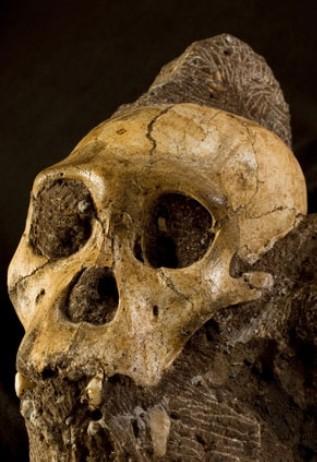(单词翻译:单击)

Science and Technology
科技
Human evolution
人类进化史
You look familiar
似曾相识
Another piece of humanity's family tree is fitted into place
南方古猿sediba的发现填补了人类家族谱系的关键空白
THE opening scene of Mel Brooks's film "History of the World: Part One" dispenses with human origins in one line: "And the ape stood, and became man."
梅尔·布鲁克斯执导的电影"世界史:序幕"开场仅用一句话就概括了人类起源:"类人猿直立起来,变成了人类。"
Would that it were that easy for palaeontologists to sort out.
要是古生物学家也能如此轻而易举地阐释人类进化的奥秘就好了。
The transition to humanity is generally agreed to have occurred between Australopithecus, a genus of small-brained, bipedal primates whose most famous member is a fossil nicknamed "Lucy", and the big-brained species Homo erectus.
人们普遍认为人类是由南方古猿和直立人之间的某个物种演化而来。南方古猿头部较小,属双足灵长类动物,其最有名的家族成员是一具被称做"露西"的化石,比较而言,直立人的头部就大多了。
But pinning down when precisely this took place, and which of the various australopithecine species were involved, has been challenging.
不过,要想确定确切的人类演化时间和哪些南方古猿物种参与了演化,仍是极具挑战性的课题。
Now the most human-like australopithecine found to date is clarifying things-and staking a claim to be the species from which early humans evolved.
目前,迄今为止发现的与人类最为相似的南方古猿正逐渐解开这团迷雾——它阐明了早期人类是由哪个物种演化而来的。
Fossils of the new species, Australopithecus sediba, were discovered in 2008 in a cave in South Africa. Initial research, led by Lee Berger of the University of the Witwatersrand, in Johannesburg, concluded that the species came too late in the fossil record to be the ancestor of the Homo lineage.
2008年在南非一个洞穴内发现一个新物种化石,称做南方古猿sediba。约翰内斯堡金山大学的李·伯格尔领导的最初研究结果表明南方古猿sediba在化石记录中出现的年份过晚而无法被认定为人类的祖先。
This week, however, a range of new research into sediba, again led by Dr Berger, has been published in Science.
然而本周,李·伯格尔博士领导的一系列关于sediba的最新研究成果在《科学》杂志上发表。
These studies conclude that sediba did in fact predate Homo erectus and, moreover, that parts of its anatomy are surprisingly similar to modern man.
这些研究结果表明,南方古猿sediba确实早于直立人存在,并且它的一些骨骼结构与现代人类有着惊人的相似之处。
The fossils examined in the Science papers are of an adolescent boy and an adult woman.
发表在《科学》杂志的该篇论文其研究对象为一个小男孩和一个成年妇女的化石。
They are well preserved, and encased in sediments that allow uncommonly precise dating.
这些化石保存完好,被封存在可进行精确年代测定的沉积物中,这实属罕见。
They lived 1.977m years ago, predating the appearance of Homo erectus by 77,000 years.
他们生活于197.7万年前,比直立人早出现7.7万年。
The period is an especially muddled one for palaeontology, being full of fragmentary fossils that are difficult to assign either to Homo or to Australopithecus.
该时期属于古生物学上极其混乱的年代,大量化石碎片都很难归类到直立人或南方古猿身上。
The sediba fossils, by contrast, have some of the most complete features in the early human record.
比较而言,南方古猿sediba化石具备了早期人类一些最完整的特征。
The new studies centre on the most telling bits of anatomy in the story of human evolution: the brain, pelvis, hands and feet.
新研究集中于与人类进化史相关的一些最具说服力的特征:如大脑,骨盆,手和脚。
The brain itself does not fossilise, but the inside of the cranium retains an impression of its contours.
大脑本身不会变成化石,但它在颅骨内保留的轮廓特征仍依稀可见。
The researchers mapped these with high-powered X-ray beams to create a three-dimensional model of the surface of sediba's brain.
研究人员采用高功率X射线束对其进行映射并绘制出sediba大脑表面的三维模型图。
They found that its size was on a par with other australopithecines, but its shape was more like that of a human brain.
他们发现sediba脑部大小与其它南方古猿并无分别,但形状却更接近人脑。
Specifically, the frontal lobes, which are the seat in modern humans of higher cognitive functions such as abstract reasoning, looked more humanlike in sediba's brain than they do in the brains of other australopithecines.
尤其是作为人类抽象推理等高认知功能区域的脑前叶部分,sediba比其它南方古猿更象人类。
That suggests the neurological changes which gave rise to humanity may have predated the brain's expansion—an event that had, hitherto, been regarded as crucial to the emergence of humans.
这表明产生人类的神经系统变化可能早于南方古猿大脑的扩张——大脑扩张至今仍被认为是人类出现的重要因素。
The hands, feet and pelvis of sediba indicate that it both climbed trees and walked upright, though with a different gait from that of humans or chimpanzees.
南方古猿sediba的手、脚和盆骨表明尽管其步法与人类或黑猩猩有所不同,但它能够爬树和直立行走。
The species may have been a toolmaker, as its hand allowed for a human-like grip.
这种物种可能还会制造工具,因为它们的手能象人类那样紧握。
Sediba's pelvis, an upright butterfly shape, is likewise reminiscent of the human one.
南方古猿sediba呈直立蝴蝶状的盆骨同样与人类相似。
It therefore sheds light on a longstanding debate: whether it was bipedalism or giving birth to babies with large heads that drove changes in the shape of the human pelvis.
因此它为长期争论的问题提供了很好的阐释:人类的盆骨形状是源自于双足行走还是为了生育大头婴儿。
Adult sediba (and therefore, presumably, their babies) had small heads, which indicates that walking upright was the advantage brought by the modern pelvis.
由于成年南方古猿sediba(据此可推知他们的子女)头部很小,这表明现代人的盆骨可带来直立行走的好处。
All of which makes sediba more similar to modern humans than are other australopithecines-and more similar, even, than Homo habilis, until now seen as one of the earliest humans.
所有这些都让南方古猿sediba比其它灵长类更象现代人——甚至比至今被认为是最早人类之一的"能人"还象现代人。
The consensus had been that habilis was a transitional form between Australopithecus and Homo erectus.
人们一致认为"能人"是南方古猿和直立人之间的过渡物种。
Dr Berger posits that sediba may have evolved directly into Homo erectus, leaving habilis as an evolutionary sideline, and not even part of the genus Homo.
李·伯格尔博士推断南方古猿sediba可能直接进化成了直立人,这使"能人"成为进化的旁支,甚至不是人属的一部分。
Slowly, then, the origin of the strange assemblage of characters that makes a human being human is emerging.
逐渐地,人类自身奇怪性格组合的起源开始出现。
As the oracle said, the beginning of wisdom is: know thyself.
正如智者所说,智慧的开端是认识自身。


